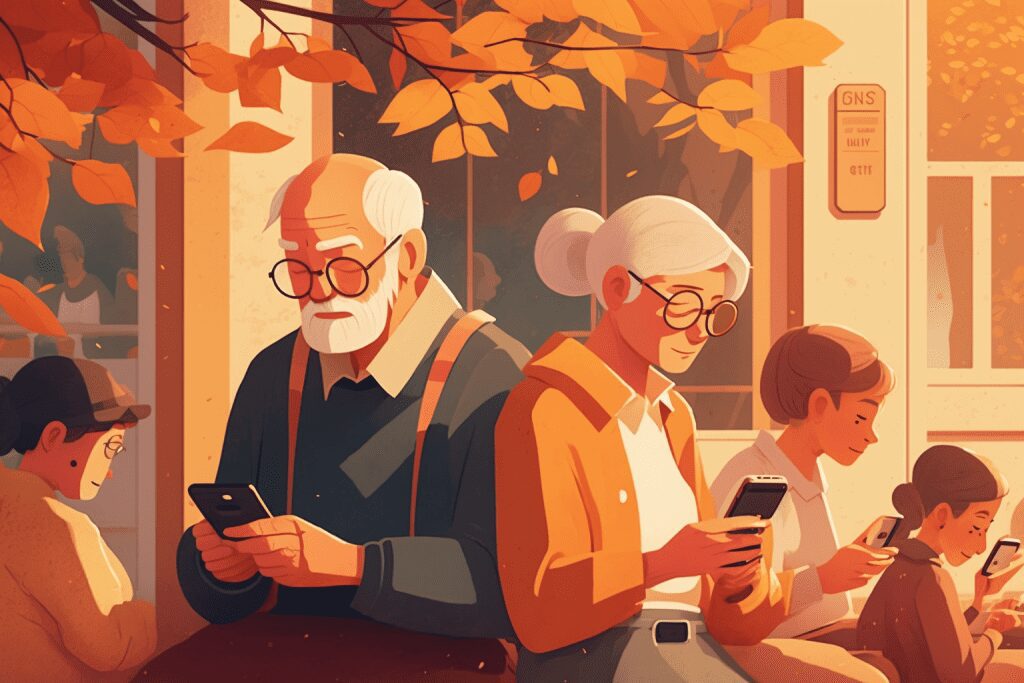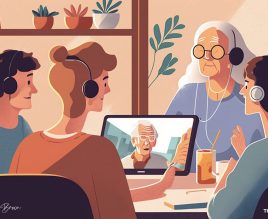Table of Contents
ToggleEnter cloud computing, cloud storage, and digital productivity tools. These modern digital tools, often perceived as complicated, can simplify daily tasks and streamline life for older adults in ways unimaginable just a decade ago. But how do they work, and more importantly, how can older adults harness the potential of cloud computing?
Cloud computing is the delivery of computing services—servers, storage, databases, networking, software, analytics, and intelligence—over the Internet (“the cloud”), offering faster innovation, flexible resources, and economies of scale. For older adults, this means they can access files, photos, or programs from any device with an internet connection, eliminating the need to store everything on a personal computer.
Cloud storage operates similarly, offering users an online space to store, manage, and back up data. Gone are the days of misplacing an important document or losing precious family photos. Now, everything is safely stored online, accessible anytime, anywhere. Digital productivity tools, on the other hand, encompass a range of applications designed to boost efficiency. From email and calendar apps that help manage appointments to note-taking apps that capture and organize thoughts, these tools transform the chaos of daily life into a neatly structured, manageable routine.
Cloud Computing for Older Adults
Cloud computing offers significant benefits for older adults, enhancing their digital experiences. It provides flexible access to files, photos, and documents from any device, eliminating the need for physical storage. It simplifies software updates, ensuring users always have the latest features and security.

Moreover, many cloud-based platforms are designed for ease of use, facilitating communication, learning, and entertainment. However, it’s crucial that older adults are provided with support and training to understand and navigate cloud computing effectively, ensuring they can leverage its full potential securely and confidently.
Understanding Cloud Computing
Cloud computing may sound like a complex tech buzzword, but at its core, it is a simple, user-friendly concept that can drastically improve the digital experience. Cloud computing is essentially using the Internet to access and store data or applications that are on servers located elsewhere, rather than on a personal computer or local server. This provides the flexibility to access important files, data, or programs from any device with an internet connection, be it a smartphone, tablet, or desktop.
For older adults, this means no longer worrying about hard drive space or losing data if their device breaks. The data isn’t tied to one physical location; it’s in ‘the cloud.’ Imagine having a magic box that you could access from anywhere, that held all your documents, photos, music, and applications, and you’re picturing cloud computing.
Benefits of Cloud Computing
For older adults, cloud computing offers numerous benefits. It ensures data safety and accessibility, freeing users from the fear of data loss due to hardware failure. It also allows for easy sharing of photos or documents with family and friends, no matter the distance.
Moreover, it offers the ability to use powerful software and applications that their device might not have the capacity to run, increasing their range of accessible digital tools. In essence, cloud computing simplifies their digital interaction, making their digital journey less stressful and more enjoyable.
Cloud Computing Service Models
There are three main cloud computing service models that users can choose from: Infrastructure as a Service (IaaS), Platform as a Service (PaaS), and Software as a Service (SaaS). IaaS offers the hardware infrastructure such as servers, while PaaS provides a platform for software development.
Most older adults, however, will interact primarily with SaaS. This service model allows users to access software applications over the Internet, like email services or photo editing tools. With SaaS, they can use applications without worrying about installation or maintenance, making it a convenient choice for older adults new to the digital world.
Popular Cloud Computing Providers
There are a multitude of companies providing cloud computing services today, but four big players dominate the market: Amazon Web Services, Microsoft Azure, Google Cloud Platform, and IBM Cloud. Each of these providers offers an array of services designed to cater to different user needs.
Amazon Web Services
Amazon Web Services (AWS) is a pioneer in cloud computing, offering a wide range of services, including computing power, database storage, and content delivery. AWS is popular for its flexibility and scalability, making it a good fit for users with varying needs. It offers user-friendly interfaces and tools for easy access to services, such as Amazon Photos for photo storage, which may be particularly useful for older adults wanting to store and share photos easily.
Microsoft Azure
Microsoft Azure offers over 200 services, covering everything from machine learning to blockchain. For older adults already familiar with Microsoft’s suite of products, like Word or Excel, Azure can be a comfortable transition into cloud computing. One of its standout services for this demographic could be OneDrive, which provides cloud storage that seamlessly integrates with other Microsoft products, offering a unified, familiar experience.
Google Cloud Platform
Google Cloud Platform provides a suite of cloud services including computing, data storage, data analytics, and machine learning. Older adults who use Google’s array of products, like Gmail or Google Photos, may find it easy to use Google Drive, their cloud storage service. This platform provides a simple, intuitive interface for users to store and access data anytime, anywhere.
IBM Cloud
IBM Cloud offers over 170 services, including advanced options like AI, blockchain, and Internet of Things (IoT). However, for older adults, IBM Cloud’s simple storage and accessibility features may be most pertinent. Watson Assistant, an AI-powered service, can be a useful tool for older adults, as it can answer questions and provide guidance, offering a simpler, more interactive way to use cloud services. While IBM may not be the first name that springs to mind for personal cloud computing, its offerings are robust and user-friendly.
Cloud Storage Solutions for Seniors
Cloud storage solutions are beneficial for seniors, providing a convenient and safe way to store and access personal data. Services like Google Drive, Dropbox, and iCloud offer user-friendly interfaces and robust security measures.
These platforms enable seniors to save photos, documents, and other files in a central location accessible from any device, eliminating concerns about losing data due to device failure. Providing seniors with appropriate guidance on using these services, understanding privacy settings, and managing data can further enhance their digital independence and peace of mind.
Overview of Cloud Storage
Cloud storage functions similarly to a hard drive on your computer, except it’s located in a secure server accessible via the Internet, and not in your personal device. It allows you to save, access, and share files like documents, photos, videos, and more from any device with an Internet connection. For seniors, cloud storage can be a life-altering tool. Imagine never having to worry about losing precious family photos or important documents. Whether it’s a cherished picture of a grandchild or a critical medical report, everything can be safely stored in the cloud.
Moreover, it offers an easier way to share memories and essential information. A vacation photo, for instance, can be uploaded to the cloud and shared instantly with family and friends across the globe. There’s no need for flash drives or complex email attachments; with a few clicks, the photo is shared securely.
Advantages of Cloud Storage
Cloud storage offers several advantages for seniors. It provides a safety net against data loss from hardware failure or device theft. It also allows easy sharing of files, promoting connection with loved ones. Moreover, it eliminates the physical limitations of traditional storage mediums, enabling access to files anytime, anywhere. Cloud storage also integrates seamlessly with many popular applications, making it easier for seniors to use digital tools. In essence, cloud storage can help older adults lead a worry-free digital life.
Types of Cloud Storage
There are three primary types of cloud storage: Personal, Public, and Private. Personal cloud storage, like Google Drive or OneDrive, is most relevant for seniors. It allows individuals to store personal data like photos, videos, and documents, with easy access and sharing capabilities.
Public cloud storage is generally used by businesses to store and distribute data widely. Private cloud storage is used by large organizations for sensitive data, offering enhanced security. For most seniors, personal cloud storage services, due to their simplicity and user-friendly interfaces, are the most suitable for everyday digital activities.
Top Cloud Storage Services
There are numerous cloud storage services available today, each offering its unique blend of features. Here, we’ll take a look at four of the most popular ones that seniors might find convenient and user-friendly.
Google Drive
Google Drive is an excellent option for seniors, especially for those already using Google services like Gmail or Google Photos. Drive offers 15GB of free storage, with the option to purchase more. It allows easy sharing, editing, and collaboration on documents, making it an all-round cloud storage solution. Its user-friendly interface and seamless integration with other Google apps make it a solid choice for older adults.
Dropbox
A Dropbox is another robust cloud storage service offering 2GB of free storage, upgradable with a subscription. Dropbox stands out for its simplicity and ease-of-use. It allows easy file sharing and has automatic photo upload features, which could be particularly useful for seniors wishing to save and share photos. With Dropbox, older adults can have a simple, straightforward cloud storage experience.
Microsoft OneDrive
For those familiar with Microsoft’s suite of products, OneDrive is an ideal choice. OneDrive offers 5GB of free storage, and its seamless integration with Windows and Microsoft Office makes it convenient for those already accustomed to Microsoft’s ecosystem. Whether it’s saving Word documents or Excel sheets, OneDrive simplifies the process for older adults, making it an attractive option for their cloud storage needs.
iCloud
iCloud is Apple’s cloud storage service, and it works seamlessly with Apple devices. It offers 5GB of free storage and integrates perfectly with other Apple services, like Photos, Notes, and Mail. For seniors who use an iPhone, iPad, or Mac, iCloud can be an easy-to-use, streamlined service for storing photos, documents, and other data, ensuring that their digital memories and important files are never more than a few clicks away.
Digital Productivity Tools for Older Adults
In the digital age, there’s an abundance of tools that can help older adults manage their time, tasks, notes, and communications more efficiently. These digital productivity tools can simplify daily routines, making life more organized and less stressful.

Types of Productivity Tools
Digital productivity tools come in various forms, each designed to streamline a specific aspect of daily life. They range from time management tools and note-taking applications to communication platforms and task management apps. Time management tools help manage schedules, track time spent on various activities, and set reminders for appointments or tasks.
Note-taking applications allow users to jot down thoughts, ideas, and important information digitally, eliminating the need for physical notebooks. Communication platforms offer an easy way to connect with friends, family, and the world, providing various modes like text, voice, and video.
Task management apps assist in organizing daily tasks, enabling users to create to-do lists, set priorities, and track progress. For older adults, these digital tools can help structure their daily activities, ensuring they get the most out of their day without feeling overwhelmed.
Time Management Tools
Google Calendar is a popular time management tool offering features like event scheduling, reminders, and shared calendars. It’s simple to use and integrates seamlessly with other Google services, making it ideal for older adults seeking to manage their time more efficiently.
Note-taking Applications
Evernote is a robust note-taking app where users can jot down thoughts, save articles, and organize notes. It’s simplicity and powerful search capabilities make it a great choice for seniors looking to digitally capture and retrieve information.
Communication Platforms
Skype and WhatsApp are excellent communication platforms for text chats, voice calls, and video calls. They offer an intuitive interface and wide accessibility, making it easy for seniors to stay connected with family and friends.
Task Management Apps
Todoist is a task management app where users can create to-do lists, set deadlines, and prioritize tasks. Its clean interface and simplicity make it a helpful tool for older adults looking to organize their tasks and enhance productivity.
Recommended Productivity Tools
The wide array of productivity tools available can make selecting the right one seem daunting. However, there are a few that stand out due to their simplicity, user-friendly design, and functionality.

Evernote
Evernote is a comprehensive note-taking app that allows you to save and organize your thoughts, articles, and to-do lists. It’s compatible with most devices, and its search functionality makes finding old notes a breeze. For seniors looking to digitize their notes and easily retrieve them, Evernote is a must-have tool.
Trello
Trello is a task management tool that uses boards, lists, and cards to organize and prioritize projects. It’s intuitive and visually appealing, making it a great choice for older adults who need to keep track of various tasks. With Trello, seniors can manage daily chores, keep track of appointments, and even coordinate family events with ease.
Slack
Slack is a communication platform primarily used for instant messaging. It’s user-friendly and allows for individual and group conversations, making it perfect for staying connected with family or participating in community groups. With Slack, older adults can chat, share files, and even make video calls, all in one place.
Google Calendar
Google Calendar is a time management tool that helps you keep track of your schedule. It’s simple to use, and you can set reminders for appointments, birthdays, or any other important dates. The ability to share calendars with family members can also help seniors coordinate plans with their loved ones. For older adults seeking a hassle-free way to manage their time, Google Calendar is an excellent choice.
Implications and Future Developments
As more and more older adults embrace digital tools, we’re witnessing a transformation in the way seniors interact with technology. From cloud computing and storage to digital productivity tools, these technologies are not just making their lives more convenient but also fostering deeper connections with their families and communities.
The growing adoption of digital tools by older adults is causing a shift in the tech industry. Companies are now designing products with user-friendly interfaces and features that cater to the needs of this demographic. These efforts extend beyond just creating simpler devices and applications, but also include creating guides and tutorials designed for older adults to help them navigate the digital landscape with ease.
Furthermore, the evolution of technology is opening up new avenues for enhancing the digital lives of older adults. Emerging technologies like AI and voice recognition are making devices more intuitive and easy to use. For instance, AI-powered assistants like Alexa or Siri can help seniors schedule appointments, make calls, or even control smart home devices, all through voice commands.
Moreover, technologies like virtual reality and augmented reality have the potential to provide immersive experiences for seniors, from virtual travel experiences to brain-training games. Telehealth is another field where technology can greatly benefit older adults, enabling remote consultations and health monitoring.
The future of technology for older adults looks promising. As we continue to innovate and develop new technologies, it’s critical to ensure they’re accessible and beneficial to seniors. By doing so, we can create a more inclusive digital world where everyone, regardless of age, can benefit from the conveniences of modern technology.
Conclusion
In the digital age, cloud computing, cloud storage, and digital productivity tools are not just technical jargon for the younger generation; they’re becoming integral parts of older adults’ lives as well. These technologies can streamline daily tasks, enhance communication, and provide a safeguard for important data and cherished memories.
Cloud computing services like AWS, Azure, Google Cloud, and IBM Cloud bring convenience and efficiency, while cloud storage solutions such as Google Drive, Dropbox, OneDrive, and iCloud ensure that precious data is never lost. Digital productivity tools, including Evernote, Trello, Slack, and Google Calendar, can simplify time management, task tracking, note-taking, and communication, making life easier and more organized.
The key is not to be intimidated by these digital tools. Instead, it’s about embracing them, understanding their benefits, and learning how to use them. For older adults, mastering these tools could lead to improved digital literacy, greater independence, and a more connected life. As technology continues to evolve, it promises to bring even more conveniences and enhancements to our daily lives. So, let’s step into the digital age with confidence and curiosity, ready to embrace the countless opportunities it brings.
FAQ
Is cloud computing secure for older adults?
Yes, cloud computing is generally secure for all users, including older adults. Providers like Amazon, Google, and Microsoft invest heavily in security measures. However, users should also take precautions, such as using strong, unique passwords and enabling two-factor authentication. It’s also important to be wary of phishing attempts. In essence, while cloud services are secure, safety also depends on the user’s vigilance and safe Internet practices.
How can older adults learn to use digital productivity tools?
There are many resources available to help older adults learn to use digital productivity tools. Online tutorials, how-to videos, and user guides are excellent places to start. Many community centers also offer computer and technology classes for seniors. Family members and friends can also be a great help. Remember, learning new technology takes patience and practice, so it’s okay to take things slow.
What are the costs associated with cloud services and productivity tools?
Many cloud services and productivity tools offer free tiers, which may be sufficient for individual use. However, for additional storage or features, there may be monthly or annual subscription fees. The costs can vary widely depending on the provider and the plan chosen. Always check the pricing details on the provider’s website or contact customer service for the most accurate information.
Can digital tools help older adults stay connected with family and friends?
Absolutely! Digital tools can play a crucial role in helping older adults stay connected. Communication platforms like Skype or Slack allow for easy messaging, voice calls, and video chats. Social media platforms offer a way to stay updated on loved ones’ lives. Cloud storage services can be used to share photos and documents. By embracing these digital tools, older adults can maintain and even strengthen their connections with family and friends.
Reference
- https://www.techtarget.com/
- https://www.ibm.com/
- https://aws.amazon.com/

















